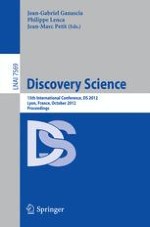This book constitutes the refereed proceedings of the 15th International Conference on Discovery Science, DS 2012, held in Lyon, France, in October 2012. The 22 papers presented in this volume were carefully reviewed and selected from 46 submissions. The field of discovery science aims at inducing and validating new scientific hypotheses from data. The scope of this conference includes the development and analysis of methods for automatic scientific knowledge discovery, machine learning, intelligent data analysis, theory of learning, tools for supporting the human process of discovery in science, as well as their application to knowledge discovery.
